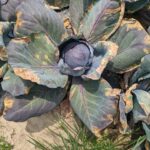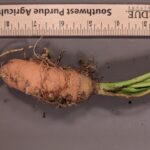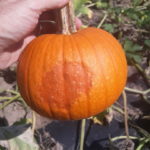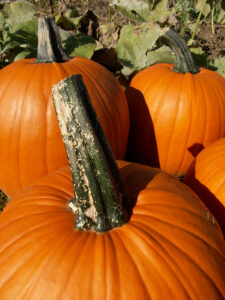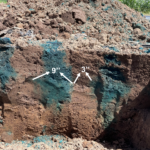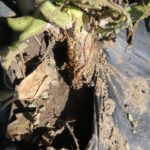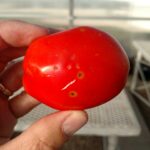Vegetable growers may be wondering when to apply the final fungicide application. It is important to leave the crop protected until the last harvest. Yet, it is important not to waste fungicides. In most cases, the last fungicide application should occur 10 to 14 days from the final harvest. Most fungicides that are designed to[Read More…]
I have observed the disease black rot of cabbage and broccoli this year. I have discussed the basics of this disease in April (Issue 701). Here, I would like to share some photos and observations. For a brief background, black rot is a bacterial disease that becomes systemic-that is, moves within the plant. The disease[Read More…]
We announced in a previous newsletter article that we are doing a survey to understand the extent of root-knot nematode (RKN) damage on vegetable crops in Indiana. Among the 18 soil samples from high tunnels of 14 farms, RKNs (juvenile or adult) were found in 13 samples at 9 farms. Only 3 farmers knew RKN[Read More…]
Pumpkin and winter squash should be harvested fully mature to reach their optimal quality and fulfill their potential shelf live. Characters indicating fruit maturity include loss of rind surface gloss, ground spot yellowing, and hardening of the skin to the level that it is resistant to puncture with a thumbnail. Except for some striped varieties,[Read More…]
Recently, I have observed several pumpkin vines and fruit with Plectosporium blight. When I receive phone calls about Plectosporium blight, the caller often has trouble describing the disease. Indeed, the disease is difficult to describe. Therefore, I will include several photos with this article. Lesions of Plectosporium blight are most often observed on the stems[Read More…]
A major difference between drip irrigation and other irrigation methods is that drip irrigation applies water to only a portion of the soil. This works great for vegetables grown on the plastic mulch, since no irrigation water is applied between the row middles; water applied to row middles encourages weed growth. So, does the soil[Read More…]
Southern blight of pepper and tomato thrives under hot, dry conditions. Usually, such conditions are more likely in August. Production under tunnels may contribute to the dry conditions that influences southern blight. This article will discuss the symptoms, biology and management of southern blight of tomato. Southern blight has a wide host range affecting many vegetable,[Read More…]
Recent heavy rains have caused an increase in foliar disease in many vegetable fields. A sudden increase in foliar disease may lead some growers to purchase expensive fungicides to take care of the problem. However, there are several considerations before one applies the most expensive fungicide. The optimum time to apply a very effective, and[Read More…]
This is the fourth article in a series that describes the three primary bacterial diseases of tomato: bacterial canker, bacterial speck and bacterial spot. This article is a general summary of management options for these diseases. All three of these diseases may be seed borne and brought into to field situation on transplants. It is[Read More…]
The following is an article in one of a series about bacterial diseases of tomato. Previously, articles about bacterial canker and bacterial spot have been featured here. The next article will be about general management methods for bacterial diseases of tomato. Bacterial speck causes lesions on all above ground portions of the tomato, in a[Read More…]

